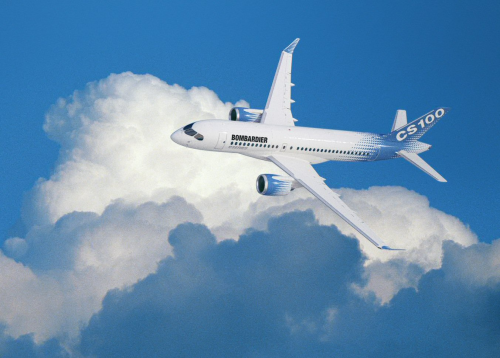
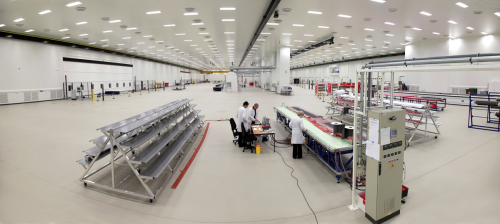
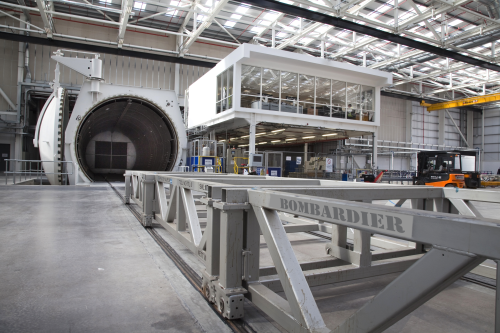
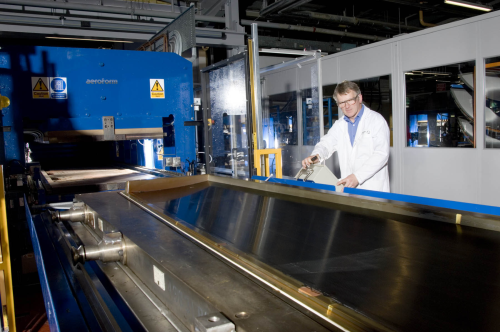
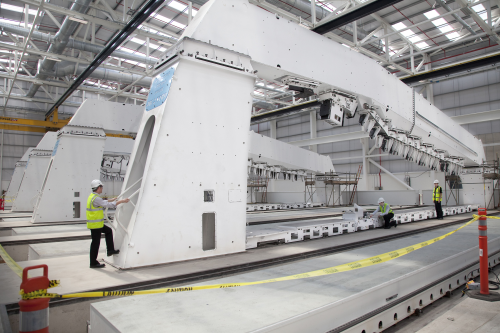
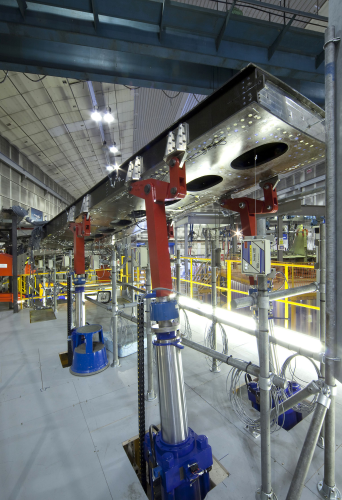
Challenging the dominant Airbus/Boeing duopoly in narrowbody ‘workhorse’ airliners is no mean undertaking, but Canada’s Bombardier Aerospace is doing just that with its CSeries twin jet, due to enter service in 2013.
Bombardier says the two CSeries models, the C100 and C300, are brand new clean-sheet designs optimised for the sub 150-seat sector, in contrast to shrunk A320 and B737 variants from Airbus and Boeing or the scaled up regional jets offered by Brazilian contender Embraer. Bombardier argues that long experience with its CRJ regional jet series and business jets equips it to make the challenge and that advanced materials, refined aerodynamics and a ‘game-changing’ engine enable the CSeries to offer a step improvement in operating economics that airlines can hardly fail to be interested in.
To beat the opposition on fuel and maintenance costs requires a light but durable airframe and to achieve this Bombardier has opted for a 46% composite structure. This, together with other advanced materials, a radical geared turbofan (GTF) engine from Pratt and Whitney and an advanced supercritical wing will, the design team confidently predicts, deliver the goods.
Interestingly, Bombardier has not followed the composite fuselage route that its Boeing and Airbus competitors have taken for their latest B787 and A350 airliners. Instead it has specified aluminium-lithium, the leading low-weight metallic competitor to aerospace composites, for most of the fuselage. Bombardier was influenced in its choice by the fact that the CSeries is a high-cycle aircraft that will be closer to the ground than a widebody and therefore more subject to damage caused by ground support equipment. The fact that such damage is readily identified and repaired in metal using standard techniques was a determining factor. Even so, the aft fuselage section, with its complex curvatures, comprises composite panels over an aluminium framework, a thin-film interface material being used at the metal-carbon composite junctions to prevent galvanic corrosion.
Overall, composite content includes the majority of the wing, the empennage and the nacelles. The advanced wing is to be built in a new facility in Belfast, Northern Ireland, where Bombardier already has a major presence. The empennage is being manufactured in Italy and the nacelle work is being undertaken by engine supplier Pratt & Whitney.
Efficient wing
The primary composite interest is in the high-efficiency wing, a crucial part of an aircraft in which the UK is a world leader producing, for example, the wings for Airbus jets.
Bombardier Belfast is entirely responsible for the design and production of the CSeries wing. By virtue of a loan for the Belfast facility, the UK government is a risk-sharing partner, one of several global partners that Bombardier has enlisted for its CSeries programme. The £520 million Bombardier is investing in the wing programme is helping the company build a 600 000 ft2 (55 740 m2) composites manufacture and assembly facility at its extensive Belfast site located near the old Harland and Wolf shipyard that once built Titanic and now turns out wind turbines.
Phase 1, a composites fabrication area, was completed on schedule in 2010. This includes a large clean room and a general fabrication area equipped with a fabric cutter, a multi-axis machining cell, a number of preformers, several large autoclaves and a non-destructive testing (NDT) suite. Phase 2 of the work is a manufacturing assembly area which is now nearing completion. Wing production is scheduled to begin there late this year.
Most of the CSeries wing, about 80% of it in fact, is composite. Specifically the torque box – the wing’s main strength member – and wing skins are of carbon fibre reinforced plastic (CFRP), as are the moving control surfaces (ailerons, spoilers and flaps). Other CFRP parts include the winglets, fixed trailing edge shrouds and main landing gear doors. However, parts of the internal stiffening structure, notably the ribs, are of aluminium alloy, together with the wing leading edge and slats, while the attachments for the engine pylons are titanium.
The metal content illustrates the tendency of designers today to make best use of both composites and metals, separately or in combination, depending on the particular structural requirements. The superior resistance of composites to fatigue and corrosion often determines a choice in their favour, but not always, as Michael Ryan, vice president and general manager of the Belfast facility, points out. Ryan argues, for example, that wing ribs can actually be made lighter in aluminium than in carbon. He explains that composites work well when the part is orientated in line with the applied load, but have to be made thicker and heavier to handle out-of-plane bending and shearing.
Novel infusion
Interestingly, the CSeries wing configuration resembles that of Airbus’ latest design, the A350, similarly having composite spars and envelope plus metal ribs. However, whereas Airbus UK relies on prepregging as its primary fabrication technology, Bombardier has developed and patented its own resin transfer infusion (RTI) process.
Vice president, engineering, business and product development, Colin Elliott told Reinforced Plastics that RTI builds on previous experience, including that of Short Brothers, predecessor company on the site, in producing control surfaces such as elevators and flaps using conventional resin transfer moulding. RTM is highly regarded for the quality of the items it yields, and the lack of need for post-machining, but it is more suitable for items of modest size than for large fabrications such as wings. One factor militating against its use for these is the heavy and expensive matched tooling that would be required. Typically, massive inconel metal moulds would need substantial cranes to lift and position them. RTI uses metal tooling for one side only – the outer mould line tool. This tool is closed on the inner side by a stiff sealed membrane so that a vacuum can be pulled inside the mould. The inner mould line tool is essentially a high-specification vacuum bag material with incorporated stiffeners and can, in itself, be of largely carbon fibre construction.
Carbon fibre plies, cut to shape by an ultrasonic cutter, are laid into the metal mould which is then vacuum bagged and placed on precision jigs into an autoclave. Resin is injected from vats outside the autoclave into the stacked ply lay-up. The closed mould is evacuated to ensure that the fibres become fully impregnated under vacuum. A cure cycle, with temperatures up to 370°C and various pressures, is then applied. After the cure, the part is removed and trimmed to final shape in a five-axis machining centre.
Colin Elliott points out that there are some similarities with prepreg processing in that resin is allowed to wet out the fibres gradually and the total cycle time for a part is in the order of 14-16 hours. The cure cycle differs little from that required for prepreg and has similar ramp and dwell times.
“We have been experimenting with RTI for almost as long as we have been using RTM in production, and that’s about eight years,” says Elliott. “Our first certified piece produced using RTI was a fan cowl door for the International Aero Engines V2500 engine. That proved successful and helped pave the way for RTI use on the CSeries. Our first application on this aircraft was making parts for the pre-production demonstrator wing that is a key part of the development programme. Now the process will be used for the large one-piece skins on production wings and the structural spars for the wing torque box.”
An important advantage of RTI compared with prepreg fabrication, explains Elliott, is that dry fabric plies can be used that are two to three times thicker than prepreg plies so that man hours and machine hours are reduced. Cycle times are lower and there is less material wastage. A higher fibre volume distribution can be obtained than with prepregs, claims Elliott, throughout composite lay-ups up to 1.25 inch thick and more. The limited shelf life of prepregs is avoided.
Initially, the plies will be laid up manually, with laser projection facilitating correct placement, but Bombardier is looking to automate the process with pick-and-place robotics that will use suction to lift each ply from the cutter bed and place it in its correct position on the ply stack. Automating the manufacture of composite parts is, of course, a constant preoccupation of producers in high labour cost countries. In this regard, it will be interesting to see, when Bombardier’s robotic automation has settled down in service, how the system compares for speed, efficacy and economics with the automated tape laying solutions of Airbus and Boeing.
More automation
Assembly is another activity ripe for automation. Take, for instance, the semi-automated production jigs being installed in the factory as part of current Phase 2 activity. These enable drilling and other operations to be carried out on CSeries wings. The latter are built vertically, like the wings for Airbus’ military airlifter the A400M but unlike the A350’s wings which are assembled horizontally. A large machining head that moves up and down the length of each jig can drill clean swarf-less holes as the wing torque box is assembled. The multi-turret machine enables the right tool to be selected for each operation in accordance with a pre-programmed routine. The numerical control software also governs drilling parameters – speeds, pressures etc.
Developing a system that could drill with high precision in all the different materials and material combinations, to a high repeatable quality and with complete extraction of swarf, was a significant challenge. This was met with the help of outside research sources such as SAMPE (Society for the Advancement of Material and Process Engineering.)
A useful precursor to the production jig system was the assembly jig used for the pre-production wing demonstrator. Lessons learned with this unit helped ensure that the final jig would deliver the required high production standards. Additionally, thousands of specimen tests were carried out by Bombardier and its suppliers in developing the system.
More automation is planned. In particular, Bombardier is investigating out-of-autoclave processing with oven curing, optimised resin chemistries and new material formulations all being researched. Some of these are in-house self-funded initiatives, but others are UK and European research programmes in which company personnel can find themselves collaborating with their peers from Airbus, GKN Aerospace and other sometime competitors. Much data has also been garnered from previous research projects such as Advanced Low Cost Aircraft Structures (ALCAS) and Aircraft Wing Advanced Technology Operations (AWIATOR).
Demonstrably the most impressive mouldings are the large single-piece skins which extend the full span of the wing. Each skin, which has integral co-cured carbon stiffeners, is infused in a single shot and cure takes place in the largest autoclave, a massive unit that is 70 ft long by 18.5 ft in diameter. Completed wing skins are fastened to the internal stiffening structure, including the aluminium ribs, mechanically.
Supplier base
Chief materials used for the wing are the carbon fibre, notably uni- and bi-directional stitch-bonded fabrics from German company SAERTEX, along with Cytec Industries’ 890 liquid epoxy infusing resin system, produced at the Cytec Engineering Materials facility at Wrexham, UK. A fine copper mesh is included in the outer skin lay-up to provide electrical continuity for lightning protection.
There are a number of significant Tier 1 sub-contractors to Bombardier’s wing programme. GKN Aerospace on the Isle of Wight is responsible for the design and production of the aircraft’s winglets, each of which comprises a carbon envelope over carbon spars and ribs. GKN Munich has responsibility for the ailerons, while Salver (Italy) is to supply the flaps and landing gear doors. AAR Composites is producing composite fairings for the flap tracks. Coast Composites, a US subsidiary of UK group Hampson Industries, is producing the metal outer mould line tooling used to fabricate the wing skins, having previously produced developmental tools for the technology demonstrator. US company Nova-Tech Engineering Ltd is setting up a European hub in Belfast after winning a contract to manage the supply, support and servicing of tooling and other equipment. New Breed Logistics, also US-based, is providing a logistics service that includes supply chain and warehouse management among other services.
More than 60 Northern Ireland companies are benefiting from the CSeries wing programme. One of these, Williams Industrial Services, is supplying preforming machines used to prepare composite materials prior to the curing process. Another, Kemfast Pass, is to manage the purchase and storage of raw materials, together with their onward delivery from a storage depot it is building near the wing factory.
Some of these companies also have long-term contracts to supply similar items and services to another programme at the Belfast facility, producing wing spars and skins for the Learjet 85 business jet. This smaller wing is also extensively composite and the double utilisation of much of the supplier base helps defray costs across both projects.
Key moments
A significant milestone in the CSeries programme was the completion of the Phase 1 factory in late 2010. Another was the arrival of the first of the specialised semi-automated assembly jigs earlier this year. Design was frozen in July 2010 and detailed design is said now to be complete.
In development terms, a premier key event was the successful testing in 2010 to ultimate load of the composite wing structure, using a three-quarter span (ie. the full-scale wing minus the last 12 ft towards the tip) pre-production demonstrator. A dozen powerful hydraulic actuators, part of an advanced hydraulic test rig, were used to apply controlled loadings on the heavily strain-gauged wing, causing it to bend. Visually, this was impressive as the wing deflected by 2 ft at its outboard end while surviving an ultimate load one and a half times the maximum load it would ever see in flight. The value of this step in validating the engineers’ stress and design assumptions was demonstrated when it proved possible to pull some material and weight out of the structure while still meeting full design requirements.
Another key event was the trial mating of a composite wing to composite wing box. Engineers tested the resulting join thoroughly, mindful of the issues Boeing had in this area with its B787. Conducted in Montreal, Canada, the tests boosted confidence in dealing with a composite-to-composite interface inside a metal fuselage. As a result, says Bombardier, it has no concerns about an aluminium-lithium fuselage attached to a carbon fibre wing box and wing.
Meanwhile, the sales campaign for the new aircraft has been gaining momentum. Airlines, conscious of the established products from the existing duopoly, hesitated at first about backing a new entrant to the narrowbody field, but some, attracted by promises of a 20% fuel burn advantage, low noise, reduced maintenance and good short field performance for the smaller C100 variant, have now taken the plunge.
First was Lufthansa, placing an order in 2009 for 30 CS100 aircraft and options on a further 30. This order from a leading airline amounted to a powerful endorsement of Bombardier’s formula of putting a game-changing engine – a turbofan with a gearbox – into an airframe of advanced materials and refined aerodynamics. Next, Irish Lease Corporation International (LCI) weighed in with an order for 17 CS300s and three CS100s. This was the first order for the larger-capacity model. In 2010 Republic Airlines announced it would buy 40 CS300s, with 40 options, for its Frontier Airlines subsidiary. (Frontier has previously been an all-Airbus operator.) So far, the Canadian airframer has clocked up 133 firm orders for its CSeries, with many expressions of interest likely to be converted into orders.
A pending milestone, due any time now (at time of writing) will be commencement of production of the CSeries wing. By 2016 Bombardier expects to have generated about 800 jobs on the programme in Belfast. Lean manufacturing principles (including 6 Sigma) will be applied in order to secure production efficiency. Key events to come include commencement of final assembly in Canada, the maiden flight expected to take place in Canada and delivery to the launch airline late in 2013. But the most telling development will not be an event, but the progressive build up of operator experience that will demonstrate whether or not this Canadian 46% composite challenger can deliver on its promise and help hard-pressed airlines make money. Only then will Bombardier know whether its bold gamble in offering a ‘new-technology airplane today’ has paid off. ♦
This article was published in the November/December 2011 issue of Reinforced Plastics magazine. To appy to receive your copy of the magazine please complete the subscription form. (The digital edition of Reinforced Plastics magazine is distributed free of charge to readers who meet our qualifying criteria.)





